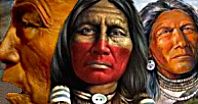|
|  |

HOHOKAM ANCIENT INDIAN CIVILIZATION

Hohokam Indians of the Tucson Basin
AUTHOR: Linda M. Gregonis & Karl J. Reinhard
About 300 B.C., the Hohokam, an agricultural group, migrated from Mexico into southern Arizona and settled in villages along the Salt and Gila rivers. As their population grew, they began settling areas around the Gila-Salt heartland.
At about A.D. 200, a few Hohokam families apparently moved to the Tucson Basin and built their homes along the Santa Cruz and Rillito rivers. These early villagers introduced a new lifeway into the area.
The Archaic people, living in small scattered camps in the basin, gradually absorbed the new lifeway. The adopted the Hohokam "rancherķa" style of living, where people occupied widely separated house groups within a village. They began making pottery and digging ditches to water the newly arrived Hohokam varieties of corn, beans, squash, and cotton.
These Tucson Basin Hohokam were soon trading for seashells, copying from the Hohokam heartland, and using such typical goods as carved stone bowls and clay human figurines. However, they also retained, in part, the seasonal hunting and gathering of their Archaic predecessors.
About half of their food was cultivated in fields, and the rest was collected by villagers who maintained seasonal camps in the mountains and foothills.
After A.D. 1100, influence from the heartland Hohokam began to dwindle, and cultural ties were strengthened with the Mogollon people to the north and east, resulting in a blend of Hohokam and Mogollon traits in the Tucson Basin.
Around A.D. 1250, villagers began building adobe-walled houses, and Hohokam potters innovated new designs and created a pottery style that was widely copied by groups around the Tucson Basin.
By 1350, some people had moved into a few large communities composed of abovegound, apartment-like dwellings, but the population as a whole seems to have declined.
The reasons for these cultural changes are not clear, but environmental deterioration (perhaps including droughts) and changes in social organization brought about by the collapse of major cultures in Mesoamerica have both been suggested as possible causes.
By 1500, the Tucson Basin Indians had resumed to living in scattered, Hohokam-like rancherķas. These people, known today as the Pimas and Papagos, were encountered by the Spanish in the 1600s, when they first entered the Tucson Basin.
The Tucson Basin Indians were a small part of the total Hohokam occupation of southern Arizona. This occupation extended from Gila Bend on the west to Globe on the east, and from the north near Flagstaff to near the Arizona-Mexico border in the south. The Gila and Salt River valleys remained the heartland of the Hohokam culture through time.
As in the Tucson Basin, the culture of the Hohokam in areas outside the heartland varied in small ways. However, each had in common a sedentary lifestyle, a dependence on agriculture, and a unique ceremonial and trading system.
SOURCE:
Excerpted from the book, 'Hohokam Indians of the Tucson Basin' by Linda M. Gregonis & Karl J. Reinhard.
Copyright © 1979.The Arizona Board of Regents
RELATED ARTICLES:
Predecesors of the Hohokam Indians
Agriculture of the Hohokam Indian
Hunting and Gathering Practices of the Hohokam
Clothing and footwear of the Hohokam
Discovery of Hohokam ruins surprises archaeologists
|
 |


|
|
| | | | | | | | |
 |
|
|

